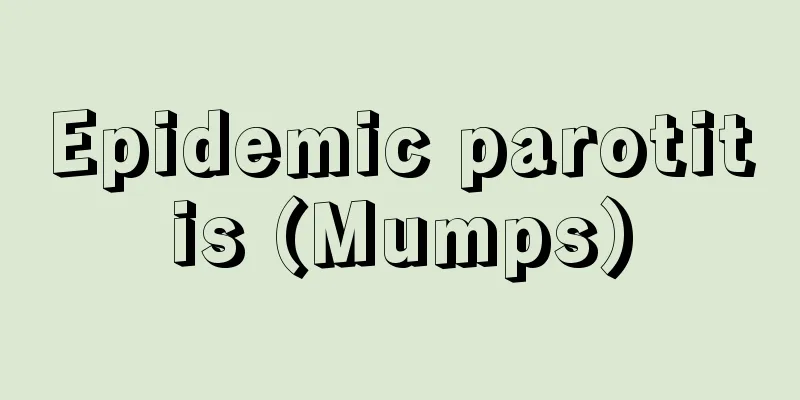Epidemic parotitis (Mumps)

What kind of infection is it? One or both parotid glands From the patient How symptoms manifest After a 2-3 week incubation period, the infection spreads to one or both parotid glands. As for complications, approximately 10% of patients who had obvious symptoms One of the major complications is hearing loss, which is said to occur in approximately 1 in 1,000 people according to recent research. It can lead to permanent damage, so caution is required. Testing and diagnosisIt is usually diagnosed based on characteristic clinical symptoms and the surrounding epidemic situation, but because the mumps virus is not the only virus that can cause parotitis, a virological diagnosis is required to prove that it is epidemic parotitis (mumps virus infection). Mumps is diagnosed by detecting mumps-specific IgM antibodies during the acute phase or by an increase in IgG antibody titers in paired serum. Recently, it has become possible to detect the viral gene (RNA) using the RTPCR method. Treatment methodsTreatment is basically symptomatic, and if complications occur, patients will often be hospitalized for treatment. The most effective method of preventing infection at present is to get vaccinated before entering a group setting. What to do if you notice an illnessMumps is classified as a Class 2 infectious disease under the School Health and Safety Act, and children will be suspended from attending school or daycare until the swelling in the parotid gland subsides. If you suspect you may have the disease, please visit your pediatrician (or internal medicine doctor for adults). Kaoruko Taya Epidemic parotitis (mumps, mumps) |
どんな感染症か 片側あるいは両側の耳下腺の 患者さんからの 症状の現れ方 2~3週間の潜伏期ののち、片側あるいは両側の耳下腺を中心として、 合併症としては、症状が明らかであった患者さんの約10%が 重要な合併症のひとつとして難聴があり、最近の研究で、頻度は約1000人に1人といわれています。永続的な障害となるので注意が必要です。その他、 検査と診断特徴的な臨床症状、まわりの流行状況などで診断されることがほとんどですが、耳下腺炎を起こすのはムンプスウイルスだけではないため、流行性耳下腺炎(ムンプスウイルス感染症)であることを証明するにはウイルス学的な診断が必要です。 急性期にムンプス特異的IgM抗体を検出するか、ペア血清でのIgG抗体価の上昇にて診断されます。また最近では、RTPCR法でウイルス遺伝子(RNA)を検出することが可能になっています。 治療の方法基本的に対症療法であり、合併症を併発した場合は入院して治療することが多くなります。集団生活に入る前にワクチンで予防しておくことが、現在とりうる最も有効な感染予防法です。 病気に気づいたらどうする流行性耳下腺炎は、学校保健安全法では第二種の感染症に属しており、耳下腺のはれが消えるまで登校・登園停止となります。発症が疑われた場合は、かかりつけの小児科(成人の場合は内科)を受診してください。 多屋 馨子 流行性耳下腺炎(ムンプス、おたふくかぜ)
|
<<: Epidemic meningitis - Epidemic meningitis
>>: Ryukoji Temple (English name) Long-yu-si
Recommend
Joint ownership
A form of joint ownership in which several people...
Alencar, J. de - Alencar
...The representative poets of this period (1830-...
Tathandlung
...There is something in consciousness that is mo...
rhyme - join
〘Noun〙① A compound word consisting of two Chinese ...
Abe tribe mountain building movement
...Masao Ushikui proposed this orogeny (1955), an...
Proustite
...There are approximately 60 known minerals that...
Dermatitis - Hifuen (English spelling)
In a broad sense, it means inflammation of the sk...
Lofoten [Islands] - Lofoten
A chain of islands stretching 200km from northeast...
Chest - Chest
〘 noun 〙 The circumference of the chest. For men, ...
Kiev (English spelling) Киев/Kiev
The capital of Ukraine. In Ukrainian it is spelle...
Correction - Ankyo
...This therapy is thought to have existed since ...
Omine 75 Waves - Omine Shichijugo Nabiki
...As practitioners became more organized, Shugen...
Alaska Pipeline
An oil pipeline stretching 1,300 km from Prudhoe B...
radiofrequency titration
...In precipitation titration and complexometric ...
Kumiodori - Kumiodori
This musical drama was created in Okinawa in the ...









